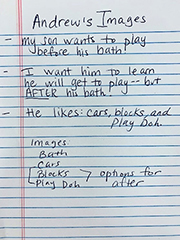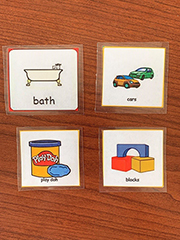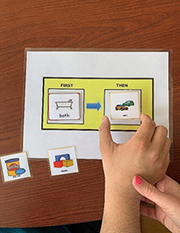Share
Employing visuals outside the classroom can be a transformative tool for the development, independence, and confidence of people with intellectual and developmental disabilities (I/DD). Although YAI’s community habilitation, employment, and day habilitation programs have used visual aids for years, many parents and caregivers don’t know how to implement them at home.
Elizabeth Asen is the Supervisor of YAI’s Project GROW program, a caregiver training group that teaches behavior management skills. Drawing from her experience as a special education teacher, she has developed a set of personalized visual supports to reinforce the techniques taught in her program.
In addition to decreasing problematic behaviors associated with communication difficulties, visual routines can help to reduce anxiety, prepare for changes in routine, and model expected behaviors for people with I/DD. Finally, for those with processing delays, illustrations pair well with verbal cues to provide clear and quick understanding of concepts and behaviors.
To better understand how to tailor visuals to meet the needs of people with I/DD, it’s important to recognize that there are several types of visuals. These range from simple visual prompts to an array of images that requires making a choice to alternative communication devices which synthesize photos, words, and phrases to communicate through images and computer-generated speech.
Making Your Own Visuals
Where should you begin? One of the central skills taught in YAI’s behavior management curriculum is “First/Then” (AKA “Grandma’s Law”). Grandma’s Law states the expected behavior first and the person’s choice, second. For example: “First you eat your dinner, then you can have dessert.”
Grandma’s Law is especially useful when someone is resistant to directions. “First/Then” provides clear instructions for expected behaviors while giving people the opportunity to have what they want.
How to Create a First/Then Board:
Materials:
- One sheet of white or colored paper
- Markers
- Scissors
- Velcro or tape
- Photos of images
- Laminating machine (optional)
- Computer/printer (optional)
Steps:
1. Think about times in which the person has difficulty transitioning between activities or lacks motivation to do certain tasks. Think of specific images that represent these activities and make a list. You can also make this list alongside the person you are supporting.

2. Take a blank sheet of paper and draw two boxes side by side. Label the left box, “first” and the right box, “then.” Leave enough space between the two boxes for an arrow that points from the left to the right box. To make the visual sturdier, you can laminate the paper. Place tape or Velcro on top of each box.

3. Collect images online, from a magazine, or draw them. Cut these into squares no larger than the “first/then” boxes. Label each image to help solidify the connection between the image and the word. Laminate each image if you like. Place Velcro or tape on the backs of the images.

4. Introduce the person to the “first/then” board. Talk about how it can help them select between certain desired activities once a required task is complete. You can model how to use it with a hand-over-hand prompt.

5. Praise them for properly using the board. Encourage and empower them to select “then,” or preferred activities, independently. You can use the board to help with difficult transitions like getting off the bus, getting out of bed, or whenever noncompliant behavior is anticipated.
This is just one example of how you can incorporate visual supports to help someone with I/DD. If you would like to learn more and are interested in taking a Project GROW class, please contact YAI LINK by calling 212.273.6182 or sending an email to link@yai.org. Participants must be unpaid caregivers of people with OPWDD eligibility who live at home with their families in Manhattan, Staten Island, or the Bronx. Please note that some visual schedule and picture routine classes are currently available to Staten Island residents only.
